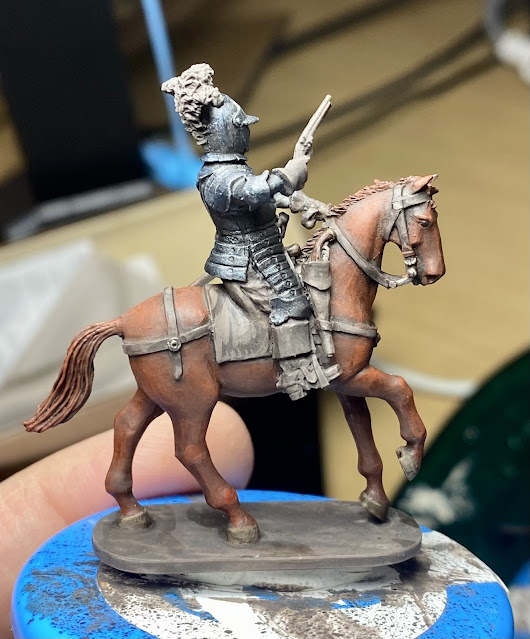This post looks at the latest unit on my painting table, a unit of Cuirassiers for my Swedish army of the 1620s.
 |
| 28mm Avanpost Cuirassiers. |
This is the second unit that I’ve created using Avanpost’s 28mm resin figures (see the previous one here: https://theviaregia.blogspot.com/2021/06/ake-totts-cuirassiers.html). I’m not very confident about the longevity of these rather fragile figures but they are lovely to paint!
After seeing someone else’s unit with different finishes of 17th century cuirassier armour (hello to Paul Mackay on Facebook!) I decided that I would have a go at a mixture of armour finishes. I have also always liked the Angus McBride illustration in the Osprey Elites title on English Civil War Cavalry that shows Haselrigge’s lobsters with three types of armour finishes. Untreated metallic armour would have rusted very quickly and so metal armour typically had some form of protective patina added.
 |
| Base coat of mixed gunmetal, black contrast and blue metallic. |
 |
| Dry brush of steel and dark wash applied. |
Blackened armour was probably the most common (and cheapest) finish and this could be achieved by coating the heated armour with linseed oil and soot. To achieve something like this on my miniatures I used a base coat of equal parts of GW Leadbelcher, VMC Blue Gunmetal and GW Contrast Black Templar. Over this a dry brush of GW Ironhands Steel, and then a final wash of thinned GW Nuln Oil. By adding more of the Blue Gunmetal in the base then a bluer finish can be achieved which was a considered a more desirable, and expensive, finish in the 17th century.
 |
| Base of gunmetal, washed with red-brown contrast. |
 |
| Dry brush of steel added. |
Russeting was another patina finish which gave a reddy-brown finish, and was most popular in the 16th century. One 17th century recipe I’ve seen for this suggested oil and vinegar. To represent this I used a base of Leadbelcher with a ‘wash’ of GW Contrast Fyreslayer Flesh. Finally a light dry brush of Ironhands Steel.
 |
| Gumetal base, dry brush with steel, and highlight with silver. Final dark wash. |
It is also possible that some individuals may have kept their armour ‘white’ (plain metal, uncoloured) if they had the available man power to constantly polish and clean it. For this I used a base coat of Leadbelcher, a dry brush of Ironhands Steel, and a wash of Nuln Oil. For a really fancy finish (for the Cornet) I painted on some VMA Silver as a highlight.
I like the final look of the cuirassier unit in their fancy armour, and it was fun to play armour with the armour recipes.
 |
| The cornet (flag) is from Mikhail Betskii Creation. |
 |
| The trumpeter rides a Piebald horse, a popular choice in the Swedish cavalry. |
As with most of my recent units I added a casualty tracker base for the unit. This uses one of the lovely Bloody Miniatures ‘Dismounted Cuirassiers’ next to a Avanpost wounded horse. The base is from Charlie Foxtrot.
Next time, back to the infantry.
Until next time,
Andy @ The Friends of General Haig (FoGH).








As always, great looking unit. Considering ratio of your cuirassiers to 'normal' reiters, you probably now have them more than Gustav II Adolf :)
ReplyDeleteMany thanks, Michal 👍. I fear you are right 😆. I was so tempted by the nice figures that I think I do have too many now. Some Fins next for GA’s cavalry, who will have much less armour. Then must get back to Husaria and cossacks.
DeleteBeautifully done Sir!
ReplyDeleteCheers, Ray, much appreciated 👍
DeleteBeautiful brushwork and wonderful back ground on armor of the period.
ReplyDeleteThank you, Pancerni 👍. The different historical recipes are fascinating and, from what I can see in social media, people have a lot of trouble replicating satisfactorily today.
DeleteWonderful unit of cuirassier! I am of the exact same opinion as you with regards to Avanpost minis: they are probably the nicest and finest sculpts I have but I have also broken some small piece off every one I have assembled.
ReplyDeleteThanks, Codsticker 👍. We shall have to hope for tougher materials in the future.
Delete